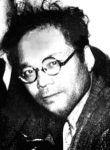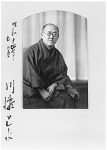Popular Artists
Born in Toyko. Given name Bunjiro. Studied as a boy with Aoyagi Bokusen and Araki Kan’yu and as an adult with Okada Saburosuke and Kaburagi Kiyokata. Exhibited Japanese-style paintings with Ugokai and Kyodokai. Inspired by Ito Shinsui’s Eight Views of Lake Biwa, which he saw at a Kyodokai exhibition. Sought affiliation with Watanabe Shozaburo by preparing sketches for prints resulting in initial prints of 4 scenes of Shiobara Hot Springs in 1918 and ultimately a lifetime of collaboration. Watanabe published over 100 prints designed by Hasui between 1918 and the 1923 earthquake, among them 2 series entitled Souvenirs of Travel (Tabi miyage), 1919 and 1923, and Twelve Tokyo Subjects (Tokyo juni dai), 1919.

Shiko Munakata:
Born in Aomori prefecture. Began self-study of oil painting and in 1920 organized Seikokai (Blue Light Group) to hold exhibitions twice a year. First went to Tokyo in 1924. Inspired to make moku-hanga by seeing a Kawakami Sumio print in 1926. Studied briefly with Hiratsuka Un’ichi in 1928. Exhibited prints with Kokugakai from 1930; member 1932-1953. Member of Nihon Hanga Kyokai 1932-1938.
Born in Niigata prefecture. Graduated from Tainan Normal School in Taiwan; worked as a teacher in Taiwan for 13 years. Returned to Japan after World War II and enrolled in the oil painting department of Musashino College of Fine Arts; graduated in 1956 at age 43. Mokuhan self-taught. First exhibited with Nihon Hanga Kyokai in 1948; member from 1952. Also exhibited with Kokugakai and Graphic Arts Club. Represented at Tokyo Biennale in 1960, 1962, and 1964 and Sao Paulo in 1967. Hoshi was strongly attracted to universal elements of nature and produced elegantly carved images of stars and constellations in the 1960s. Focused on trees in his later years.** Taken in whole, or in part, with permission from: Merritt, Helen and Nanako Yamada. Guide to Modern Japanese Woodblock Prints: 1900-1975. University of Hawaii Press: Honolulu. 1992.
Born in Kurume, Fukuoka prefecture. Original name Ueda Hiroshi. Studied with Yoshida Kasaburo, his adoptive father. Also studied with Tamura Soritsu in Kyoto in 1893; went to Tokyo in 1894 to study with Koyama Shotaro at Fudosha. In 1899 traveled in the U.S. with Nakagawa Hachiro; exhibited paintings in New York, Boston, and elsewhere. Founding member of Taiheiyogakai in 1902.
Bio Not Available
Go: Ichiryusai, Ichiyusai, Ryusai, Tokaido Utashige. Ukiyo-e painter, printmaker. Lived in Edo; son of an official of the fire department assigned to Edo Castle. Early interest in art, his first teacher Okajima Rinsai; then tried unsuccessfully to enter Utagawa Toyokuni’s studio; at about 14 became a pupil of Utagawa Toyohiro. Also studied nanga painting under Ooka Umpo; interested in Western art and the work of the Shijo school. Gave up his hereditary position in the fire department to his son, leaving himself free to devote himself to painting and designing prints. In 1812, took name of Hiroshige. His first published work, in the field of book illustration, dates from 1818; during the following decade Hiroshige published capable work in the field of figure prints: actors, warriors and girls. …
Born in Tokyo. Original name Ito Hajime. Started working in drawing department of a Tokyo printing company at age 12; then studied with Kaburagi Kiyokata. Well known as Japanese-style painter; exhibited at Bunten, Teiten, and Nitten. Discovered by Watanabe Shozaburo in 1916; Watanabe and Shinsui collaborated for 25 years; Watanabe exported hundreds of Shinsui prints. Shinsui’s landscape series Eight Views of Lake Biwa (Omi Hakkei), 1917-1918, inspired Kawase Hasui, another prolific collaborator with Watanabe. Shinsui’s early prints of bijin-ga, among his finest, include the series Twelve Figures of New Beauties (Shin bijin juni sugata), 1922-1923. After the 1923 Kanto earthquake he continued to make many prints of bijin-ga including 2 series of 12 prints each entitled Collection of Modern Beauties (Gendai bijin shu), 1929-1931 and 1931-1936. …
Bio Not Available
Bio Not Available


